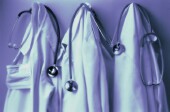
MONDAY, Aug. 20 (HealthDay News) — Nearly half of American physicians say they’ve experienced at least one of the key telltale signs of professional burnout, a new national survey says.
The observation, which the survey investigating team called “alarming,” stems from responses provided by nearly 7,300 doctors, including those on the front lines of emergency care, internists, neurologists, family physicians, dermatologists, pediatricians and preventive medicine specialists.
And the revelation raises concerns about the negative impact physician distress might have on quality of care.
“Does it surprise me that a good proportion of physicians experience some form of elevated stress?” said Terrance Bedient, vice president of the Medical Society of the State of New York, in Albany. “No, it does not. Everyone is subject to the stresses of personal issues and social concerns related to the family. But physicians also labor under particularly high expectations and demands, increasingly limited independence, and a dropping rate of compensation, historically speaking, for their work.”
Bedient, also director of the medical society’s committee for physician health, was not a part of the survey team.
The study authors, led by Dr. Tait Shanafelt from the department of internal medicine at the Mayo Clinic in Rochester, Minn., report their findings online in the Aug. 20 issue of the Archives of Internal Medicine.
Shanafelt’s team administered the survey in 2010 to a sampling from an American Medical Association database to assess the prevalence of emotional exhaustion, enthusiasm dissipation, cynicism, depression, suicidal tendencies, negative views on work-life balance and low professional esteem among the nation’s doctors.
The authors found that just shy of 46 percent of participants, overall, said they had experienced at least one symptom of burnout.
Nearly 38 percent specifically said they were subject to “high emotional exhaustion,” while almost 30 percent said that cynicism was an issue. More than 12 percent cited having a low sense of personal accomplishment.
How does this stack up against non-physicians? A random sampling of American adults outside the medical field revealed that while roughly 38 percent of doctors experience burnout, that figure drops to less than 28 percent among the general public. More physicians also report being unhappy with their work-life balance than non-physicians (roughly 40 percent vs. 23 percent).
Not all doctors, however, report an equal tendency toward professional unhappiness. The survey suggested that many of the medical community’s first responders — including ER docs, internists, neurologists and family physicians — are most likely to suffer some form of burnout stress. In contrast, dermatologists, pediatricians and preventive medicine doctors were found to be among the least likely physicians to experience such issues.
Bedient said the findings, combined with changes in the health care environment, “should be of concern to anyone who is interested in having good access to a great physician. And I would say that it’s important that we make sure that we help these doctors learn how to reach out to family members as well as to those in their work environment for the help they need.”
An accompanying research letter in the journal shed some light on the workload of a U.S. general internist. In addition to examining and talking to patients, routine tasks include placing orders for lab tests, imaging tests and consultations, writing and signing prescriptions, online communications about patient care and dictation.
Combined, the 82 internists in that study completed nearly 90,000 office visits in 2010. Their average age was about 50 and they had been practicing for a little more than 13 years, on average.
Bedient said medical community support is there for physicians experiencing burnout.
“For example, we dealt with a surgeon who was having a very difficult time, in her case, with transferring over from open surgical procedures to robotic surgical procedures,” he said. “She was experiencing a great deal of stress over that process. But we were able to successfully connect her to a support structure that was able to help her deal with it.”
“State medical and physician support programs, which are already in place in every state in the country, have been extraordinarily successful in helping doctors with this and other kinds of stress-related problems,” Bedient said. “The difficulty is that physicians, like people in general, often have trouble figuring out where to turn for help. So we really have some work to do to encourage physicians to look at their own stresses, figure out what kind of help they need, and to feel comfortable reaching out for that help when they need to.”
Survey co-author Dr. Colin West, at the Mayo Clinic’s divisions of general internal medicine and biomedical statistics, agreed that “efforts to promote physician well-being are critically important.”
“This is relevant to patients and doctors alike, because physician burnout and dissatisfaction have been linked to poorer patient outcomes, medical errors, patient dissatisfaction and serious physician issues such as suicidality,” West said. “Also, with health care reform and anticipated increased demand for front-line care providers, the severity of distress among these physicians is particularly concerning.”
“The findings of increased distress in front-line providers,” West added, “and worsened distress among physicians relative to other groups of working Americans, should further stimulate targeted research on potential solutions for physicians.”
More information
For more on physicians and stress, visit the American Academy of Orthopaedic Surgeons.

